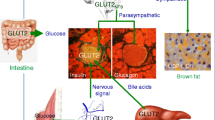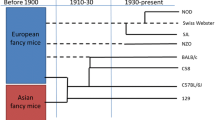Abstract
Selenium is a trace element that, although toxic in higher concentrations, is essential for human and animal health. In this study, we looked at microarray-based gene expression patterns from liver and gastrocnemius tissues in mice fed either a selenium-deficient diet or diets containing sodium selenite, selenomethionine, or a yeast-derived selenium supplement. A p value cutoff of 0.01 was used to identify a select set of selenium-responsive genes that were consistently differentially expressed across three age groups of mice with both ANOVA and t test analyses. A total of 19 gene transcripts were found to be differentially expressed across the three age groups with at least one selenium-deficient/selenium-supplemented diet comparison. Of those 19 genes, 12 had been previously identified as selenoprotein-encoding genes, and four of the genes, Gpx1, Selh, Sep15, and Sepw1, were differentially expressed in both tissues, all three mouse age groups, and all three diet comparisons. Activities associated with non-selenoproteins encoded by selenium-responsive genes included transport and stress response. The selenophosphate synthetase 2 gene Sephs2 in gastrocnemius tissue and the solute carrier gene Slc48a1 in liver tissue, both up-regulated with selenium-deficient diets compared to all three selenium-supplemented diets, are previously overlooked candidates for dietary selenium marker genes.

Similar content being viewed by others
References
Deger Y, Mert H, Mert N, Yur F, Kozat S, Yoruk IH, Sel T (2008) Serum selenium, vitamin E, and sialic acids concentrations in lambs with white muscle disease. Biol Trace Elem Res 121:39–43
Sun S (2010) Chronic exposure to cereal mycotoxin likely citreoviridin may be a trigger for Keshan disease mainly through oxidative stress mechanism. Med Hypotheses 74:841–842
Saliba W, El Fakih R, Shaheen W (2010) Heart failure secondary to selenium deficiency, reversible after supplementation. Int J Cardiol 141:e26–27
Hesketh J (2008) Nutrigenomics and selenium: gene expression patterns, physiological targets, and genetics. Annu Rev Nutr 28:157–177
Hatfield DL, Yoo MH, Carlson BA, Gladyshev VN (2009) Selenoproteins that function in cancer prevention and promotion. Biochim Biophys Acta 1790:1541–1545
Moghadaszadeh B, Beggs AH (2006) Selenoproteins and their impact on human health through diverse physiological pathways. Physiology 21:307–315
Reeves MA, Hoffmann PR (2009) The human selenoproteome: recent insights into functions and regulation. Cell Mol Life Sci 66:2457–2478
Kryukov GV, Castellano S, Novoselov SV, Lobanov AV, Zehtab O, Guigo R, Gladyshev VN (2003) Characterization of mammalian selenoproteomes. Science 300:1439–1443
Castellano S, Novoselov SV, Kryukov GV, Lescure A, Blanco E, Krol A, Gladyshev VN, Guigo R (2004) Reconsidering the evolution of eukaryotic selenoproteins: a novel nonmammalian family with scattered phylogenetic distribution. EMBO Rep 5:71–77
McSheehy S, Yang L, Sturgeon R, Mester Z (2005) Determination of methionine and selenomethionine in selenium-enriched yeast by species-specific isotope dilution with liquid chromatography-mass spectrometry and inductively coupled plasma mass spectrometry detection. Anal Chem 77:344–349
Lovell MA, Xiong S, Lyubartseva G, Markesbery WR (2009) Organoselenium (Sel-Plex diet) decreases amyloid burden and RNA and DNA oxidative damage in APP/PS1 mice. Free Radic Biol Med 46:1527–1533
Dvorska JE, Pappas AC, Karadas F, Speake BK, Surai PF (2007) Protective effect of modified glucomannans and organic selenium against antioxidant depletion in the chicken liver due to T-2 toxin-contaminated feed consumption. Comp Biochem Physiol C Toxicol Pharmacol 145:582–587
Ebeid TA (2009) Organic selenium enhances the antioxidative status and quality of cockerel semen under high ambient temperature. Br Poult Sci 50:641–647
Gabrashanska M, Teodorova SE, Petkova S, Mihov L, Anisimova M, Ivanov D (2010) Selenium supplementation at low doses contributes to the antioxidant status in Trichinella spiralis-infected rats. Parasitol Res 106:561–570
Mahmoud KZ, Edens FW (2003) Influence of selenium sources on age-related and mild heat stress-related changes of blood and liver glutathione redox cycle in broiler chickens (Gallus domesticus). Comp Biochem Physiol B Biochem Mol Biol 136:921–934
Pappas AC, Acamovic T, Surai PF, McDevitt RM (2006) Maternal organo-selenium compounds and polyunsaturated fatty acids affect progeny performance and levels of selenium and docosahexaenoic acid in the chick tissues. Poult Sci 85:1610–1620
Goulet AC, Watts G, Lord JL, Nelson MA (2007) Profiling of selenomethionine responsive genes in colon cancer by microarray analysis. Cancer Biol Ther 6:494–503
Stoytcheva ZR, Berry MJ (2009) Transcriptional regulation of mammalian selenoprotein expression. Biochim Biophys Acta 1790:1429–1440
Rao L, Puschner B, Prolla TA (2001) Gene expression profiling of low selenium status in the mouse intestine: transcriptional activation of genes linked to DNA damage, cell cycle control and oxidative stress. J Nutr 131:3175–3181
Barnes KM, Evenson JK, Raines AM, Sunde RA (2009) Transcript analysis of the selenoproteome indicates that dietary selenium requirements of rats based on selenium-regulated selenoprotein mRNA levels are uniformly less than those based on glutathione peroxidase activity. J Nutr 139:199–206
Zhang H, Dong Y, Zhao H, Brooks JD, Hawthorn L, Nowak N, Marshall JR, Gao AC, Ip C (2005) Microarray data mining for potential selenium targets in chemoprevention of prostate cancer. Cancer Genomics Proteomics 2:97–114
Food Additives Permitted in Feed and Drinking Water of Animals; Selenium Yeast: Department of Health and Human Services, Food and Drug Administration (Final rule). Federal Register 68:170 (September 3, 2003) p. 52339
Connolly CD, Power RF, Hynes MJ (2004) Validation of method for total selenium determination in yeast by flame atomic absorption spectrometry. Biol Trace Elem Res 100:87–94
Koh TS, Benson TH (1983) Critical re-appraisal of fluorometric method for determination of selenium in biological materials. J Assoc Off Anal Chem 66:918–926
Affymetrix (2004) GeneChip expression analysis: data analysis fundamentals. Affymetrix, Inc., Santa Clara
Sunde RA (1990) Molecular biology of selenoproteins. Annu Rev Nutr 10:451–474
Dawson KA (2006) Nutrigenomics: feeding the genes for improved fertility. Anim Reprod Sci 96:312–322
Sunde RA (2010) mRNA transcripts as molecular biomarkers in medicine and nutrition. J Nutr Biochem. doi:10.1016/j.jnutbio.2009.1011.1012
Papp LV, Lu J, Holmgren A, Khanna KK (2007) From selenium to selenoproteins: synthesis, identity, and their role in human health. Antioxid Redox Signal 9:775–806
Schomburg L, Schweizer U (2009) Hierarchical regulation of selenoprotein expression and sex-specific effects of selenium. Biochim Biophys Acta 1790:1453–1462
Sunde RA, Raines AM, Barnes KM, Evenson JK (2009) Selenium status highly regulates selenoprotein mRNA levels for only a subset of the selenoproteins in the selenoproteome. Biosci Rep 29:329–338
Allmang C, Wurth L, Krol A (2009) The selenium to selenoprotein pathway in eukaryotes: more molecular partners than anticipated. Biochim Biophys Acta 1790:1415–1423
Gromadzinska J, Reszka E, Bruzelius K, Wasowicz W, Akesson B (2008) Selenium and cancer: biomarkers of selenium status and molecular action of selenium supplements. Eur J Nutr 47(Suppl 2):29–50
Hooven LA, Butler J, Ream LW, Whanger PD (2006) Microarray analysis of selenium-depleted and selenium-supplemented mice. Biol Trace Elem Res 109:173–179
Bosse AC, Pallauf J, Hommel B, Sturm M, Fischer S, Wolf NM, Mueller AS (2010) Impact of selenite and selenate on differentially expressed genes in rat liver examined by microarray analysis. Biosci Rep 30:293–306
Renna M, Faraonio R, Bonatti S, De Stefano D, Carnuccio R, Tajana G, Remondelli P (2006) Nitric oxide-induced endoplasmic reticulum stress activates the expression of cargo receptor proteins and alters the glycoprotein transport to the Golgi complex. Int J Biochem Cell Biol 38:2040–2048
Xiang R, Zhao S (2009) RTN3 inducing apoptosis is modulated by an adhesion protein CRELD1. Mol Cell Biochem 331:225–230
Cunha IW, Carvalho KC, Martins WK, Marques SM, Muto NH, Falzoni R, Rocha RM, Aguiar S, Simoes AC, Fahham L, Neves EJ, Soares FA, Reis LF (2010) Identification of genes associated with local aggressiveness and metastatic behavior in soft tissue tumors. Transl Oncol 3:23–32
Griffith OL, Melck A, Jones SJ, Wiseman SM (2006) Meta-analysis and meta-review of thyroid cancer gene expression profiling studies identifies important diagnostic biomarkers. J Clin Oncol 24:5043–5051
Lefort K, Mandinova A, Ostano P, Kolev V, Calpini V, Kolfschoten I, Devgan V, Lieb J, Raffoul W, Hohl D, Neel V, Garlick J, Chiorino G, Dotto GP (2007) Notch1 is a p53 target gene involved in human keratinocyte tumor suppression through negative regulation of ROCK1/2 and MRCKalpha kinases. Genes Dev 21:562–577
Muthusamy V, Duraisamy S, Bradbury CM, Hobbs C, Curley DP, Nelson B, Bosenberg M (2006) Epigenetic silencing of novel tumor suppressors in malignant melanoma. Cancer Res 66:11187–11193
Nakagawa H, Liyanarachchi S, Davuluri RV, Auer H, Martin EW Jr, de la Chapelle A, Frankel WL (2004) Role of cancer-associated stromal fibroblasts in metastatic colon cancer to the liver and their expression profiles. Oncogene 23:7366–7377
Gashaw I, Dushaj O, Behr R, Biermann K, Brehm R, Rubben H, Grobholz R, Schmid KW, Bergmann M, Winterhager E (2007) Novel germ cell markers characterize testicular seminoma and fetal testis. Mol Hum Reprod 13:721–727
Saaf AM, Halbleib JM, Chen X, Yuen ST, Leung SY, Nelson WJ, Brown PO (2007) Parallels between global transcriptional programs of polarizing Caco-2 intestinal epithelial cells in vitro and gene expression programs in normal colon and colon cancer. Mol Biol Cell 18:4245–4260
Meyer K, Lee JS, Dyck PA, Cao WQ, Rao MS, Thorgeirsson SS, Reddy JK (2003) Molecular profiling of hepatocellular carcinomas developing spontaneously in acyl-CoA oxidase deficient mice: comparison with liver tumors induced in wild-type mice by a peroxisome proliferator and a genotoxic carcinogen. Carcinogenesis 24:975–984
Bohlig L, Friedrich M, Engeland K (2010) p53 activates the PANK1/miRNA-107 gene leading to downregulation of CDK6 and p130 cell cycle proteins. Nucleic Acids Res. doi:10.1093/nar/gkq796
Leonardi R, Rehg JE, Rock CO, Jackowski S (2010) Pantothenate kinase 1 is required to support the metabolic transition from the fed to the fasted state. PLoS One 5:e11107
Ramaswamy G, Karim MA, Murti KG, Jackowski S (2004) PPARalpha controls the intracellular coenzyme A concentration via regulation of PANK1alpha gene expression. J Lipid Res 45:17–31
Ewaschuk JB, Naylor JM, Zello GA (2005) D-lactate in human and ruminant metabolism. J Nutr 135:1619–1625
Flick MJ, Konieczny SF (2002) Identification of putative mammalian D-lactate dehydrogenase enzymes. Biochem Biophys Res Commun 295:910–916
O’Callaghan KM, Ayllon V, O'Keeffe J, Wang Y, Cox OT, Loughran G, Forgac M, O’Connor R (2010) Heme-binding protein HRG-1 is induced by insulin-like growth factor I and associates with the vacuolar H + -ATPase to control endosomal pH and receptor trafficking. J Biol Chem 285:381–391
Xu XM, Carlson BA, Irons R, Mix H, Zhong N, Gladyshev VN, Hatfield DL (2007) Selenophosphate synthetase 2 is essential for selenoprotein biosynthesis. Biochem J 404:115–120
Zhang S, Rocourt C, Cheng WH (2010) Selenoproteins and the aging brain. Mech Ageing Dev 131:253–260
Liao SF, Brown KR, Stromberg AJ, Burris WR, Boling JA, Matthews JC (2010) Dietary supplementation of selenium in inorganic and organic forms differentially and commonly alters blood and liver selenium concentrations and liver gene expression profiles of growing beef heifers. Biol Trace Elem Res. doi:10.1007/s12011-12010-18685-12012
Author information
Authors and Affiliations
Corresponding author
Rights and permissions
About this article
Cite this article
Mallonee, D.H., Crowdus, C.A., Barger, J.L. et al. Use of Stringent Selection Parameters for the Identification of Possible Selenium-Responsive Marker Genes in Mouse Liver and Gastrocnemius. Biol Trace Elem Res 143, 992–1006 (2011). https://doi.org/10.1007/s12011-010-8894-8
Received:
Accepted:
Published:
Issue Date:
DOI: https://doi.org/10.1007/s12011-010-8894-8




